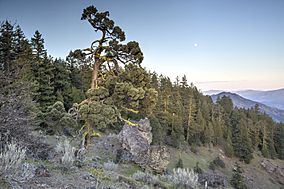Cascade–Siskiyou National Monument facts for kids
Quick facts for kids Cascade–Siskiyou National Monument |
|
|---|---|

Pacific Crest Trail at Cascade–Siskiyou
|
|
| Location | Jackson County, Oregon and Siskiyou County, California, United States |
| Nearest city | Ashland |
| Area | 114,000 acres (460 km2) |
| Established | June 9, 2000 |
| Governing body | Bureau of Land Management |
| Website | Cascade–Siskiyou National Monument |
The Cascade–Siskiyou National Monument is a special protected area in the United States. It covers about 114,000 acres (that's like 86,000 football fields!) of forests and grasslands. This monument is located where two big mountain ranges meet: the Cascade Range and the Siskiyou Mountains. You can find it in southwestern Oregon and northwestern California.
The Bureau of Land Management takes care of this monument. It was first created by President Bill Clinton in June 2000. Later, in January 2017, President Barack Obama made it even bigger.
Contents
History of the Monument
People have lived in this area for thousands of years. We know this because scientists have found old dwelling sites and places where Native Americans gathered food. These sites belonged to tribes like the Modoc, Klamath, and Shasta.
By the 1880s, new settlers moved into the region. You can still see old mining cabins from that time. The monument also has cool natural features. One is Pilot Rock, which is the hard, inner part of an ancient volcano. It looks a bit like Devils Tower in Wyoming.
Exploring the Monument's Geography
Monument Boundaries
The famous Pacific Crest Trail goes right through the monument. This trail is popular with hikers who walk long distances. On top of Soda Mountain, there's a fire lookout tower. It was built in 1962 to help spot forest fires. Even though there are many radio and TV towers nearby, the view from the fire lookout is amazing.
From the lookout, you can see big mountains like Mount Shasta and Mount McLoughlin. On clear days, you might even see the rim of Crater Lake.
The way the monument's land is used has been a topic of discussion. People want to find a good balance. They want to protect rare plants and animals. They also want to allow fun activities like hiking and some farming, like cattle grazing. There are still some private lands inside the monument's borders. A group called the Southern Oregon Land Conservancy helps protect a large private area near Siskiyou Summit.
Monument Expansion
In 2015, many scientists said the monument should be made bigger. They believed this would help protect even more of its unique nature. Local groups and leaders also supported this idea.
For example, the Ashland and Talent City Councils and their Mayors agreed. Even some private landowners, who owned land in the suggested expansion area, supported it.
However, some local county leaders did not agree with the expansion. A group called the "No Monument Tribe" was against the monument entirely.
Despite these different opinions, President Barack Obama expanded the monument in January 2017. He added about 48,000 acres to it. This included land in both Northern California and Oregon. After the expansion, there were some legal discussions about the new boundaries.
Plants and Animals

The Cascade–Siskiyou National Monument is special because it was created to protect its amazing variety of life. It has one of the most diverse ecosystems in the Cascade Range. This means it has many different types of habitats and living things.
Over 200 kinds of birds live here, including some that are rare or endangered. You might also find amphibians like the rough-skinned newt.
The monument is also known for its many different plants. Because it has various elevations and habitats, you can find a spectacular range of flowers. Some plants are unique to this area, like Green's mariposa lily. The federally endangered Gentner's fritillary flower also grows here.



